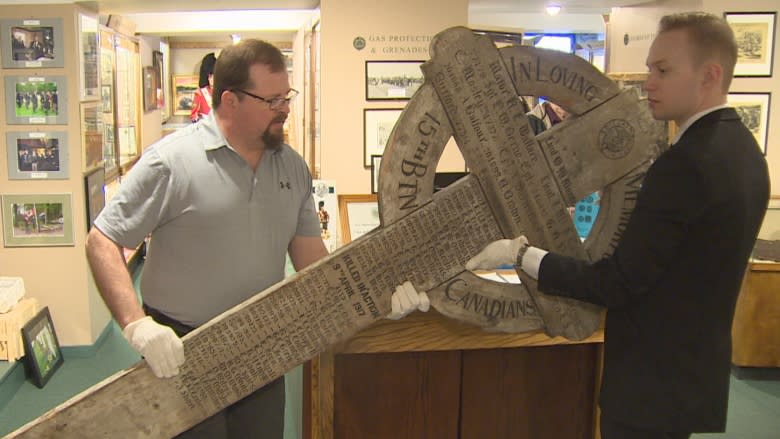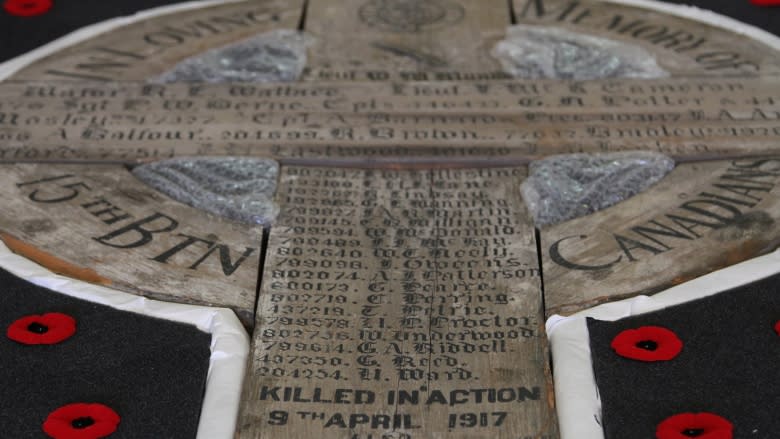101-year-old cross honouring Canadians of Vimy Ridge battle returns to Toronto
A 101-year-old battlefield cross inscribed with the names of 57 Canadians killed in the Battle of Vimy Ridge returned to Toronto Sunday.
The wooden cross was hanging on display in a museum dedicated to the 48th Highlanders regiment in the basement of St. Andrew's Church in the city's downtown core.
The rare relic made the voyage back to France last year where it stood tribute to Canada's war dead at the new visitors centre — a short distance from the iconic limestone twin pillars at the Vimy Ridge memorial.
The large regimental Celtic-style cross of the 15th Battalion (48th Highlanders) was raised on the battlefield, shortly after the assault on Vimy Ridge started on April 9, 1917.
Etched on its surface are the names of 57 Canadian soldiers, most from the 15th Battalion, who were killed in the first hours of that assault.
Although there were other wooden crosses fashioned by regimental carpenters to mark the makeshift mass graves for soldiers killed in action, this is one of the very few to survive one of the world's most hideous conflicts.
Since the First World War, the relic has also crossed the ocean three times. Its return to Toronto was both a homecoming and a reunion for many Canadians who it helped connect with the stories of relatives and memories buried by the passage of time.
Orlando Wilcox is one of the soldiers honoured on the cross. He worked as a diamond setter before the war and enlisted with his twin brother, Lorenzo, who survived the war. Wilcox was only 27 at his death, according to his great nephew Richard Merritt.
Merritt attended the reunion ceremony at St. Andrew's Church Sunday.
He says seeing Wilcox's name on the cross has helped bring him closer to his great uncle's legacy. Wilcox's relatives previously inherited photos and a pistol before receiving his medals and a letter he wrote at the front last year from a B.C. man who found Wilcox on the battlefield.
"It's quite a remarkable story," said Merritt.
Scott Keen's great grandfather, Edwin, was in the first wave of the battle. He was killed immediately by a bullet sometime between 5:15 and 5:30 a.m. on April 9, 1917. Seeing his name on the cross helped bring him closer to the man for whom he names his own son.
Keen first learned about his great grandfather's story two years ago and was at the church when the cross moved to France last year.
"I'm glad to be here today to be able to see it come back into its home," he told CBC Toronto.
"In a way it's a double-edged sword. The cross belongs with the men over there, but it's the only memory I have of my great grandfather, so it's really important for me to have it here."
This makes it a real-time partial record of the heavy Canadian losses in those pivotal opening moments of the battle.
The 15th Battalion was tasked with taking on the eastern edge of the ridge, which meant advancing over a longer distance, and through more German lines than other Canadian units. Despite their quick advance, this meant heavy casualties.
The regiment suffered 265 casualties during the assault.
The cross was brought over to Canada in 1923 by the Commonwealth War Graves Commission, and had been on display for years in the regimental museum in Toronto, until it returned to France on loan for the 100-year anniversary of the Battle of Vimy Ridge.




